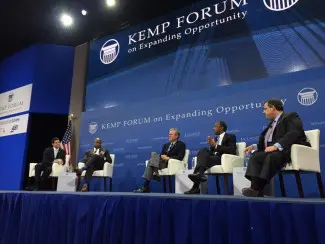 This past weekend, Speaker Paul Ryan and Senator Tim Scott hosted Republican Presidential candidates in South Carolina at the Jack Kemp Foundation Forum on Opportunities to discuss policies to reduce poverty and expand opportunity in America. Regardless of your political affiliation, we can all agree that poverty, particular among young children who experience the highest rates of poverty, requires effective bipartisanship policies and solutions.
This past weekend, Speaker Paul Ryan and Senator Tim Scott hosted Republican Presidential candidates in South Carolina at the Jack Kemp Foundation Forum on Opportunities to discuss policies to reduce poverty and expand opportunity in America. Regardless of your political affiliation, we can all agree that poverty, particular among young children who experience the highest rates of poverty, requires effective bipartisanship policies and solutions.
We therefore commend Speaker Ryan, Sen. Scott, Sen. Rubio, Sen. Graham, Gov. Kasich, Gov. Christie, Jeb Bush, Mike Huckabee, and Ben Carson for giving voice to such an important topic that is rarely highlighted in presidential debates.
But let’s cut to the chase. In order to get real about child poverty, we must do more than hold forums and conferences, or even write blogs. We need to hold ourselves accountable to reducing child poverty by establishing a target to cut child poverty in half in ten years.
This has been done before with success. In 2000, the UK established a national child poverty target, which united the Tory and Labour parties behind a goal of halving child poverty in ten years. Through a mixture of investments for children, measures to make work pay, and efforts to increase financial support for families, the British government (using an absolute, or fixed, measure of poverty) halved child poverty by 2010.
The bicameral Child Poverty Reduction Act (H.R. 2408/S. 2224) would establish a national target to reduce the number of children living in poverty in the U.S. by one-half in 10 years and eliminate child poverty in 20 years. It would accomplish this important goal by implementing a process to identify the most effective anti-poverty interventions and creating a federal interagency work group to develop a poverty plan, to improve coordination and efficiency in existing initiatives and programs, and to offer recommendations regarding ways to reduce child poverty with coordinated strategies that address employment opportunities, wage disparities, housing needs, early childhood programs and services, healthcare, nutrition, racial and gender disparities, and other real life issues that impact poor children and their families.
Simply put, it would establish a mechanism for us to deliberate on the merits of coordinated strategies to reduce and eliminate poverty and arrive at the best solutions on how to lift over 15 million children out of poverty.
Just recently, in the FY 2016 omnibus spending legislation, Congress began work to assess the societal costs and effects of child poverty as well as the impact of anti-poverty programs by including funding for such a study by the National Academy of Sciences and U.S. Department of Health and Human Services. The study will provide valuable information leading to the establishment of a target and the implementation of strategies to meaningfully reduce child poverty.
250 groups nationwide have already endorsed the Child Poverty Reduction Act. We urge lawmakers from both sides of the aisle and Presidential candidates to not ignore this momentum, and take action to establish a national child poverty target.
Getting real about reducing child poverty: http://bit.ly/1RiMOmr We must do more than hold forums and conferences v/ @First_Focus
![]() Tweet this now.
Tweet this now.
Do you share our vision of making America a better place to be a child and raise a family? Then you should be a part of The Children’s Network, a movement led by individuals, non-profit organizations, and businesses committed to the health, education, and well-being of children in the United States.Become a part of the network and receive exclusive materials, updates, and opportunities to take action on behalf of our children.
First Focus Campaign for Children is a bipartisan organization advocating to making children and families the priority in federal policy and budget decisions. You can support our work by making a donation or joining The Children’s Network to receive updates and action alerts.
